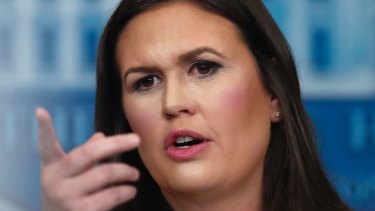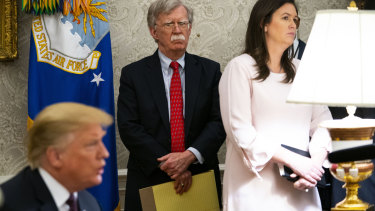White House Press Secretary Sarah Sanders is stepping down, two years after taking the job from a battered Sean Spicer. Serving the Trump administration in the position with unswerving loyalty, Sanders has accomplished something her 30 predecessors could not: rendering the position obsolete.
White House press secretary Sarah Huckabee Sanders.Credit:AP
That, of course, was her brief. She leaves the position with the admiration of the President, not his disdain, a rarity in the extensive series of administration exits. She is able to do so because she served not the presidency but the President, furthering Donald Trump’s goal of diminishing the press to the point that a press secretary seemed unnecessary.
Sanders hasn’t held a public briefing – once the lifeblood of the White House press corps – since March 11, more than three months ago. The sporadic briefings, though, were more symptom than problem. Journalists learned early in her tenure that, like her predecessor who started his tenure picking fights about inaugural crowd sizes, Sanders had little compunction about lying. Press secretaries have always spun stories in favour of the administration, but have never had such a cavalier attitude toward outright lies.
So much of what happens in the Trump administration is quickly labelled unprecedented that it’s worth pulling apart what actually is. After all, presidents have long used press secretaries to massage the day’s news, spinning it in favour of the administration. The White House press corps was institutionalised over several years by presidents from both parties, including Theodore Roosevelt, Woodrow Wilson and Franklin Roosevelt, because they believed it was the most effective way to govern. A democracy, they believed, required citizens to be aware of the choices their government was making.
So presidents worked with journalists to build a new set of institutions that gave the journalists – first those in newspaper publishing and then those in radio and television – easy access to the White House. Notably, that included presidents like Warren Harding, who as a newspaper publisher knew exactly how important it was to cultivate relationships with the media (though, as he learned, not even having an in with publishers could prevent papers from covering major scandals).
Of course, it was that inability to control the press that made the White House press corps so important. It mattered that the messages of the administration were covered by independent journalists. Fears of propaganda were growing in the 1930s and 1940s, just as the press secretary’s role was becoming formalised. That someone who spoke with the voice of the president faced regular questioning from the press corps played a powerful role in legitimising democratic governance. Perhaps the press corps didn’t challenge officials as much or as pointedly as some would wish, but the regular back-and-forth between the press corps and the press secretary were important exercises in oversight and transparency.
The press secretary had also become important because the federal government had grown so large. Over the course of the 20th century, the president was administrating a massive bureaucracy, so co-ordinating one message about the activities and goals of the sprawling federal state became an increasingly important job. The press secretary shaped that message: when they did their job poorly, it gave the impression of an administration in chaos; when they did it well, it radiated a sense of hyper-competence.
Of course, the press secretary’s job was also one of managing the press, and presidents have regularly chafed at the idea that interlocutors were getting between them and the people. New media offered a work-around. Franklin Roosevelt could go on radio and speak directly to Americans, creating a personal relationship with voters without any journalistic interference. Richard Nixon, facing a mounting financial scandal after being chosen as Dwight Eisenhower’s running mate in 1952, did not hold a press conference: he secured airtime on television, so he could take his case directly to the American people.
US President Donald Trump (left) and National Security Adviser John Bolton with Sarah Sanders in the Oval Office.Credit:New York Times
Donald Trump, too, has thrived in a media environment that allows him to cut out the press. But unlike his predecessors, he doesn’t just look for alternatives to the fourth estate: he seeks to discredit and destroy it. That’s because, whatever the limitations of journalists these days, they still value facts and accuracy – two things the Trump administration sees as major obstacles.
While White House press briefings served to highlight the tensions between the administration and the press – a valuable piece of performance art for Trump’s base – the uncontrolled clashing allowed journalists to counter Sanders’ arguments with facts, and began making heroes of the journalists who challenged the administration’s lies.
As a result, the press briefings went from on-camera spectacles to off-air clashes to infrequent affairs. Wanting a free shot at messaging, President Trump has relied far more on Twitter than the briefing room, and so Sanders became more of an adviser than a press secretary. In many ways, her formal role at the White House ended months ago.
But her absence as much of her presence aided the Trump administration’s larger project: dismantling the systems that brought journalistic oversight into the White House. And while that’s a project that furthers the administration’s goals – particularly protecting the President from investigation and impeachment – it’s one more worrisome sign for democracy.
Nicole Hemmer is a regular columnist based in the United States.
Source: Read Full Article

